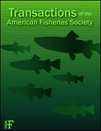Fish Fauna Associated with Drifting Seaweed in the Coastal Area of Tongyeong, Korea
Abstract
Fishes associated with drifting seaweed were investigated monthly between April 1998 and March 1999 in the coastal area of Tongyeong, Korea. Depending on the size of seaweed patches, we collected fish by dip net, purse seine, or surface trawl. The behavior of fish in and around drifting seaweed was observed by scuba diving and in an aquarium. The most abundant types of seaweed were in the genus Sargassum, including S. horneri, S. miyabei, and S. thunbergii. The size of seaweed patches varied by season; patches larger than 4 m in diameter were found in May, whereas patches smaller than 50 cm in diameter were abundant in August and September. Patch weights varied from 0.1 to 11.0 kg in spring and summer but averaged less than 1 kg in autumn. We collected a total of 56 fish species from 27 families, the number of species varying from season to season. We found the most species in May (N = 29) and June (N = 26), and the fewest in February (N = 1). Some species, including Syngnathus schlegeli, Hexagrammos agrammus, Histrio histrio, Petroscirtes breviceps, Rudarius ercodes, and Stephanolepis cirrhifer, were present for 6 to 9 months, whereas Mugil cephalus, Siganus fuscescens, and Furcina osimae were collected only once during the study period. There was no significant relationship between the number of species collected and the weights of the seaweed patches (P < 0.05).
Introduction
“Drifting seaweed” is defined as a patch of seaweed floating near shore that moves by wind or wave action. Such patches are used by zooplankton and juvenile fish as shelter or feeding sites and as aids in migration (Safran and Omori 1990). Species composition of drifting seaweed has been intensively studied in Japan (Segawa et al. 1959a, 1959b, 1959c, 1960a, 1960b, 1961a, 1961b, 1961c; Ikehara and Sano 1986). The fish communities associated with drifting seaweed (Uchida and Shojima 1958; Ida et al. 1967) and the preferences of fish for drifting seaweed have also been studied (Senta 1966a, 1966b, 1966c). In Korea, juvenile Seriola quinqueradiata and Thamnaconus modestus (see Table 1 for common names) are collected for use in aquaculture between June and July, when the drifting seaweed patches float towards the South Sea. The study of drifting seaweed is thus very important to our understanding of the ecological and economic value of these patches. To estimate fisheries resources, populations of juvenile Seriola quinqueradiata in floating seaweed have been observed by Japanese research airplanes (Mitani 1965a, 1965b, 1965c, 1967). However, no study has been conducted for this purpose in Korea.

Tongyeong, the study area, is affected directly by the warm Tsushima current, which originates in Southeast Asia. Water temperatures range from 10°C to 27°C in the course of the year, allowing the area to maintain the characteristics of a coastal region. Therefore, both temperate and subtropical fishes show diverse life history patterns (KORDI 1998, 1999). The main objective of our study was to assess seasonal changes in the fish communities associated with drifting seaweed, along with the relationship between the size of these patches and the number of fishes found in them. An additional objective was to understand the ecological patterns of the dominant species, Seriola spp., Sebastes spp., and Thamnaconus modestus, which are used in Korean aquaculture.
Methods
Fishes associated with drifting seaweed were collected and observed once or twice a month while cruising the coastal area from Sanyang-myon to Kaldo or Koam, and from Tongyeong Kyungsang nam-do to Hongdo, Korea, between April 1998 and March 1999 (Figure 1). We measured the water temperature and the salinity monthly at two stations, one near Daejangdudo (A) and the other near Yokgido, Chwasarido (B), using a salinometer (YSI-85, SCOOT). The research vessel Ocean, (2.99 tons) was used to collect the fish fauna associated with drifting seaweed patches.
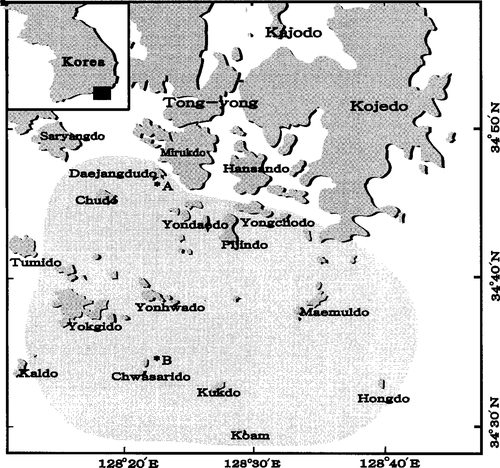
Map showing the sampling area (light shading) in the coastal waters of Tongyeong, Korea; A and B indicate stations for measuring water temperature and salinity
Three types of net were used to collect samples, depending on the diameter of the target seaweed patch. A purse seine net (30 m × 7–10 m; Figure 2A) was used to collect patches larger than 2 m in diameter, a surface trawl (1.5 × 1.5 × 6 m, the front being 5.5 × 5.5 mm and the back 4.3 × 3.5 mm; Figure 2B) for patches 1–1.5 m in diameter, and a dip net (diameter 0.7 m, 1.8 × 1.8 mm; Figure 2C) for patches smaller than 1 m in diameter. During each sampling period, we collected more than 20 patches of drifting seaweed, along with their associated juvenile fish.
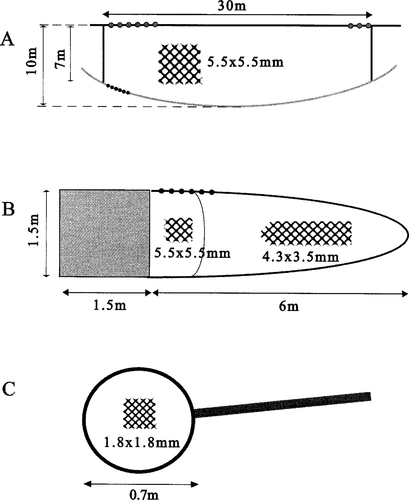
Gears used to collect fish in drifting seaweed: (A) Purse seine, (B) surface trawl, and (C) dip net
Fish samples were preserved in a 5% formalin solution immediately after capture and brought to the laboratory. They were counted and their total length and body lengths were measured to the nearest millimeter. Identification (Uchida et al. 1958; Chyung 1977; Okiyama 1988; Nakabo 1993; Kim 1997) and meristic and morphometric measurements of fish were made with an anatomical microscope (OLYMPUS-SZH). To investigate fish behavior in drifting seaweed, observations were carried out both in coastal waters (by scuba diving) and in an aquarium maintained for this purpose.
We used Shannon's index of species diversity (Shannon and Weaver 1963) to estimate the monthly diversity of the fish communities, that is,:

Results
Environmental Factors
Water temperatures ranged from 10.7°C to 26.8°C during the study period, with no substantial differences between the two sampling sites, although temperatures were slightly higher at site B in August, September, and January (Figure 3). Salinity ranged from 29.8‰ to 34.2‰, with no differences between the sites (Figure 4).
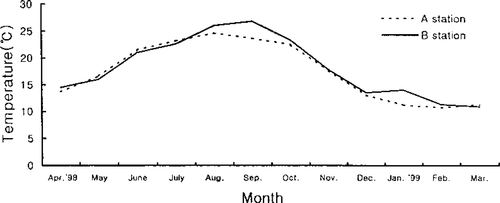
Monthly fluctuations of water temperature at stations A and B in the study area
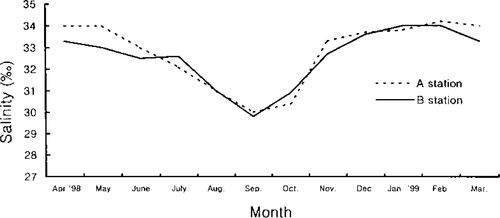
Monthly fluctuations of salinity at stations A and B in the study area
Composition of Drifting Seaweed
During the study period, the most abundant seaweed species in the drifting patches were Sargassum spp., followed by Zostera spp., Pachymeniopsis lanceolata, and Camphyleophora crassa. Fragments of ropes, nets, and branches were often found tangled among the patches. Seaweed patches greater than 4 m in diameter were found mostly in May, after which the mean size decreased. Patches smaller than 50 cm in diameter were found most frequently in August and September (Figure 5). Weights of patches ranged from 0.1 to 11.0 kg in spring and summer, but averaged less than 1 kg in autumn (Figure 6).
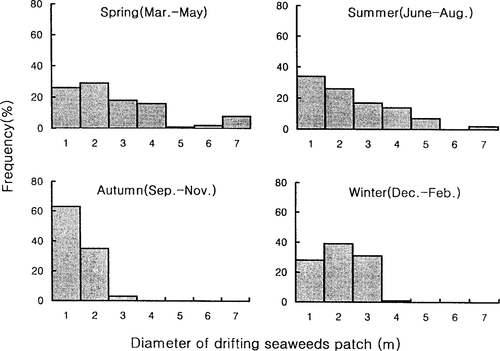
Seasonal variation in the diameter of drifting seaweed patches in the coastal area of Tongyeong, Korea
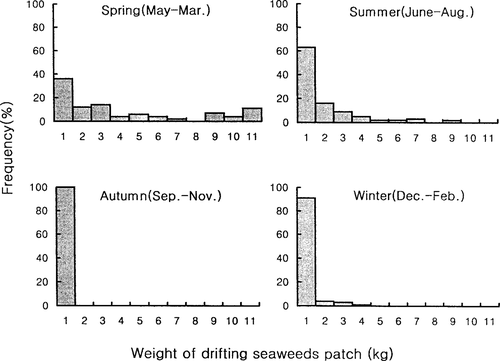
Seasonal variation of the weight of drifting seaweed patches in the coastal area of Tongyeong, Korea
Fish Communities
Fishes associated with drifting seaweed were classified into 57 species from 27 families during the 1-year sampling period. Perciformes were the dominant group (28 species), followed by Scorpaeiformes (8 species) and Tetraodontiformes (6 species; Table 1). The fishes observed in the drifting seaweed were most diverse between May and July, the number of species decreasing from autumn to winter. The greatest number of species (N = 29) was identified in May, and Seriola quinqueradiata, Stephanolepis cirrhifer, Sebastes thompsoni, and Histrio histrio were the most abundant species. By August–September, the number of species in drifting seaweed had decreased to eight; by February, only one species, Pholis crassispina, was collected.
The seasonal pattern of fish occurrence (Table 2) included 34 species collected in spring, the most abundant being Hexagrammos agrammus, Pholis nebulosa, Pholis crassispina, and Sebastes thompsoni. In summer, 32 species were collected, including Histrio histrio and some of the same species that had been collected in the spring (e.g., Hexagrammos agrammus and Pholis nebulosa). Many juvenile Seriola quinqueradiata were also collected in the summer. In autumn, the number of species decreased to 12, and Syngnathus schlegeli, Petroscirtes breviceps, and Rudarius ercodes were abundant. Only seven species (including Rudarius ercodes) were collected during the winter.
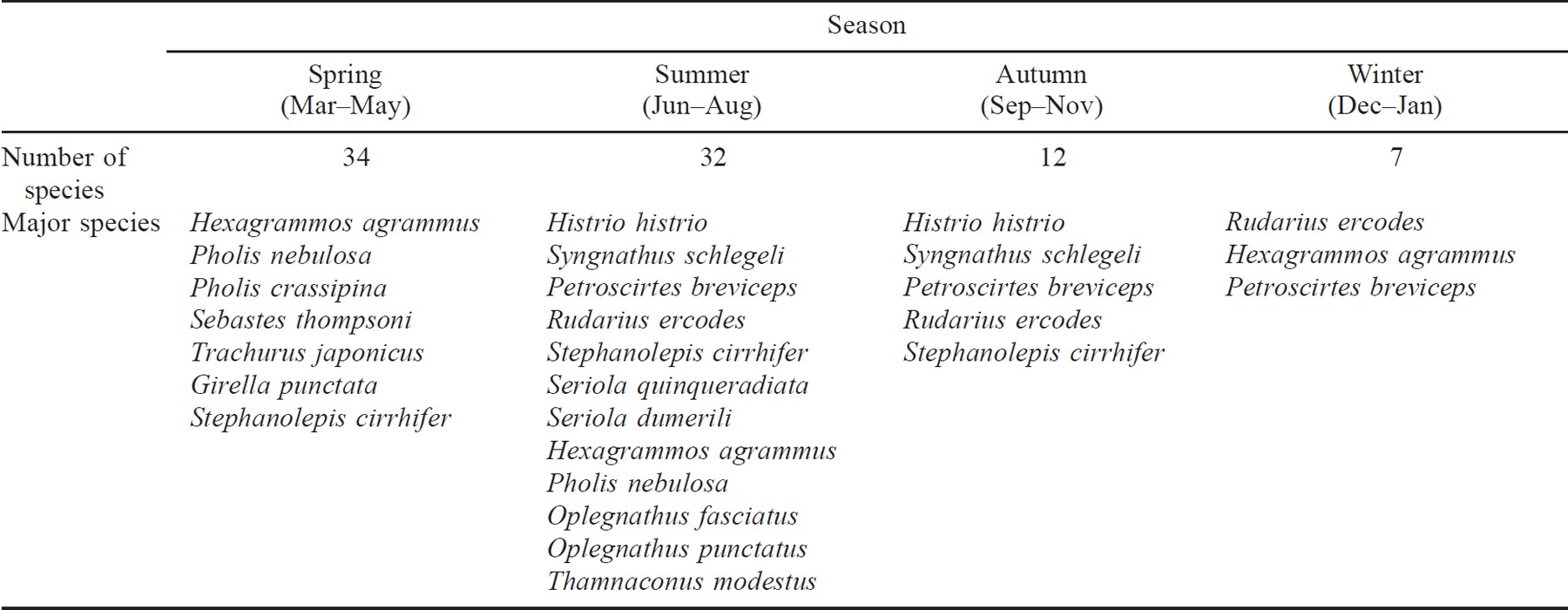
Among the fish communities identified, some species, such as Hexagrammos agrammus, Petroscirtes breviceps, Syngnathus schlegeli, and Rudarius ercodes, were present for 8–9 months, whereas Mugil cephalus, Siganus fuscescens, and Furcina osimae were collected only a couple of times during a particular season. Seriola quinqueradiata were sampled only between May and July, while Coryphaena hippurus, Chaetodon modestus, and Kyphosus sp. were found only in May and June.
Fish species and their dominance (fish/m3) by type of sampling net used are shown in Tables 3–5. The total number of species sampled by dip net was 38, with Rudarius ercodes showing a high frequency of occurrence (FO) of 89.1%. The diversity index of the dip-netted samples was greatest in May (H′ = 1.56) and least in February (H′ = 0; Tables 3–5).
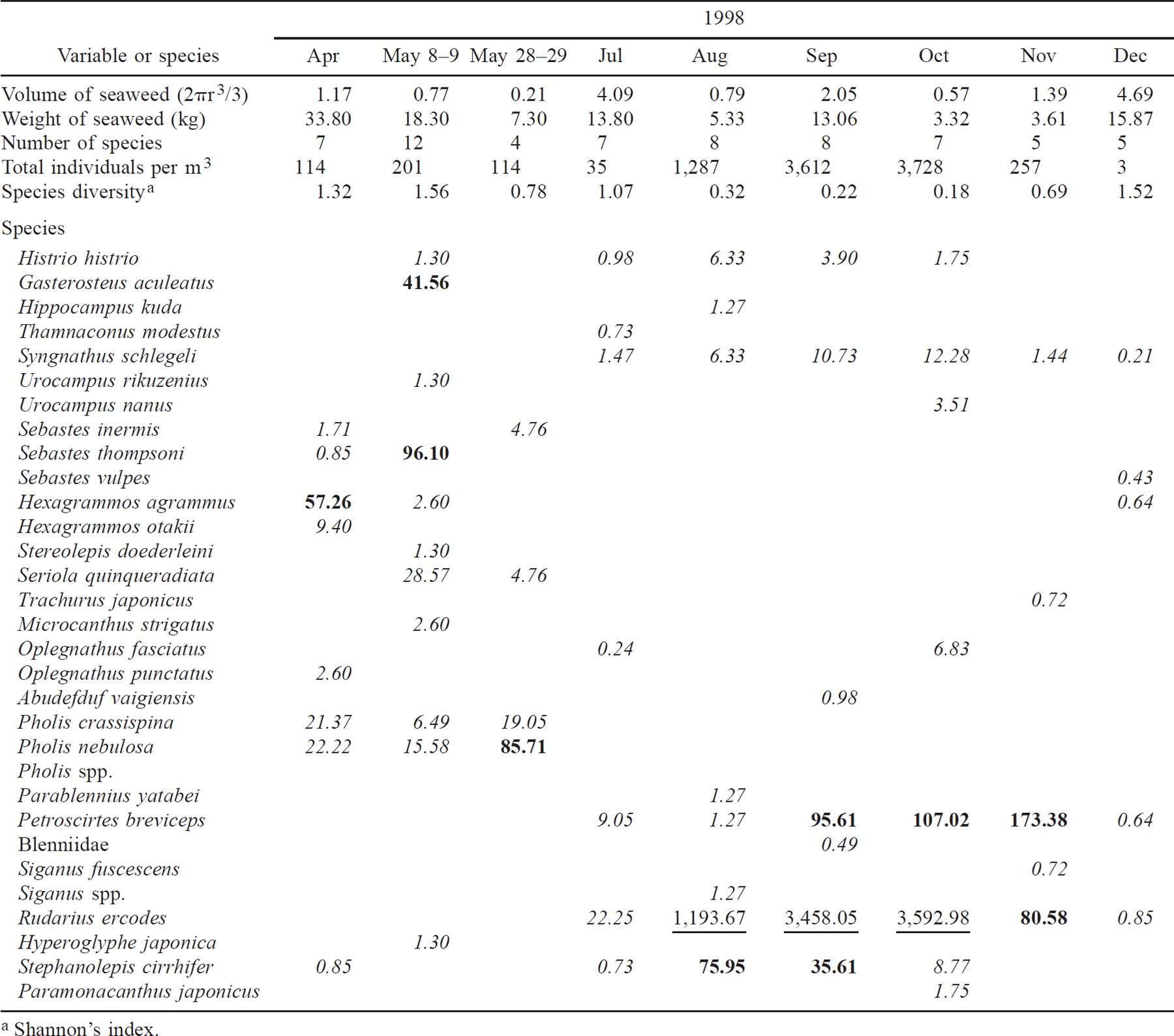
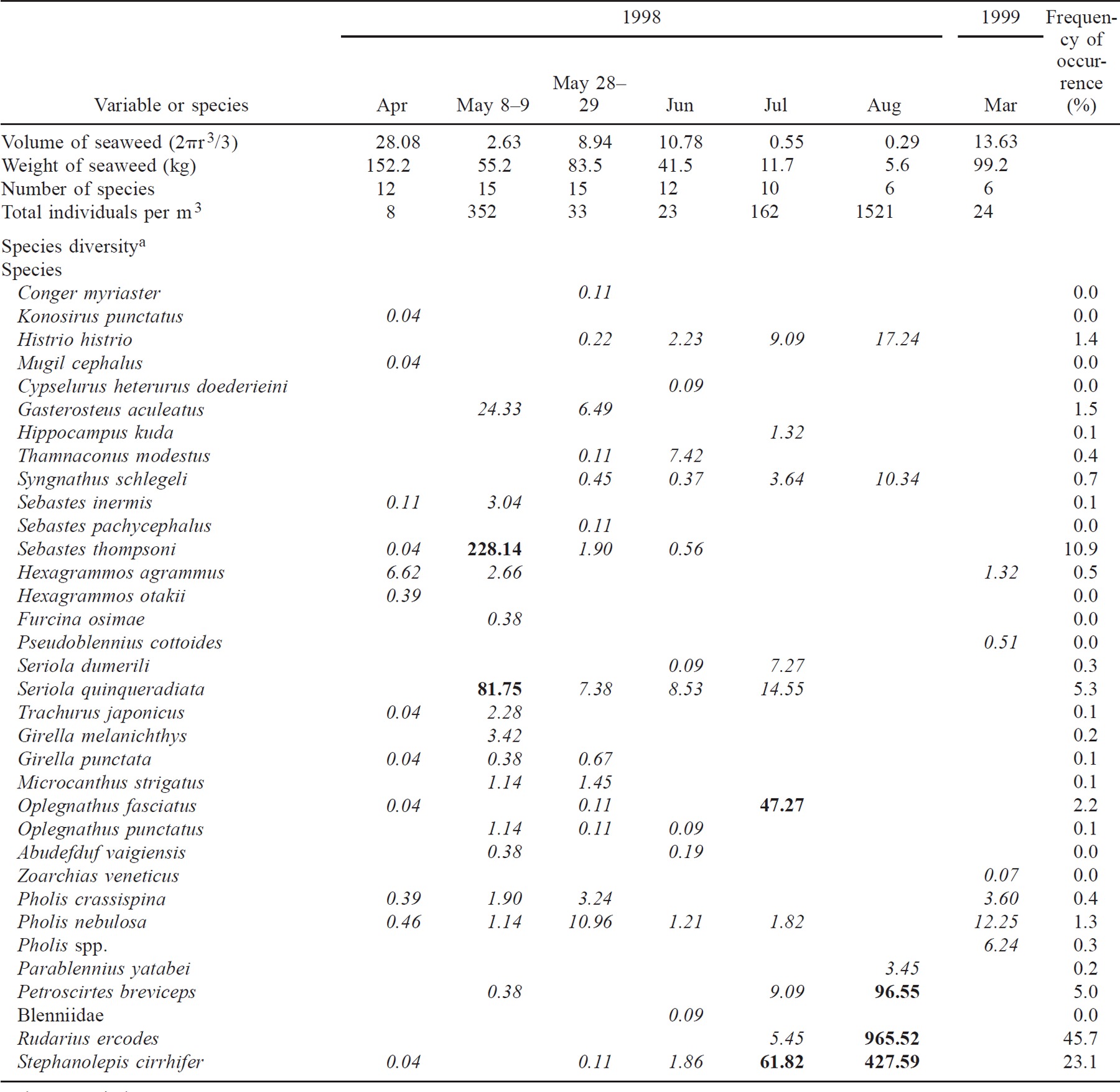
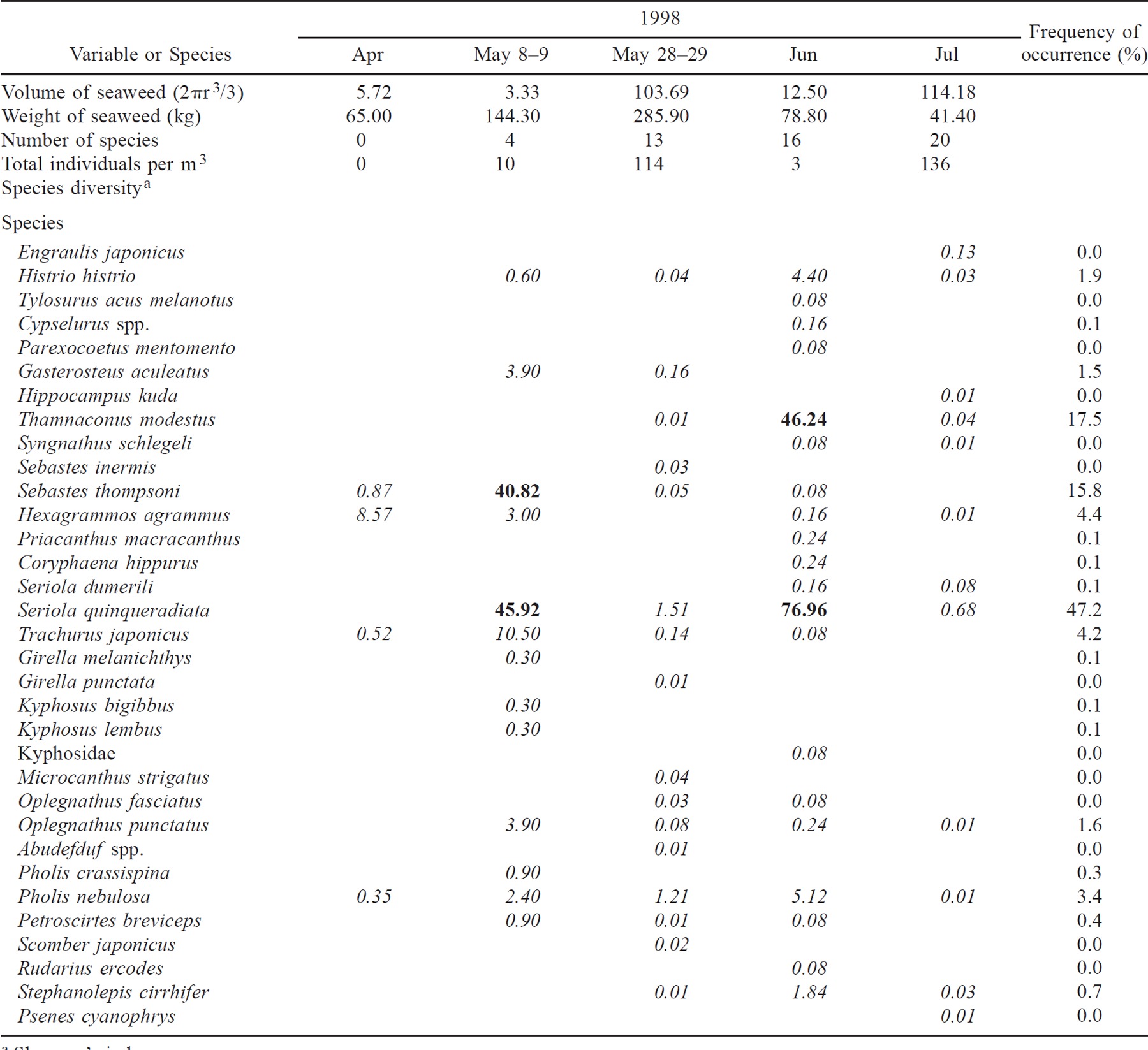
We collected 31 fish species by surface trawl. In this sample Rudarius ercodes, Seriola quinqueradiata, and Sebastes thompsoni had the highest FO values. The diversity index of this method was greatest in May (H′ = 2.23) and least in August (H′ = 0.92), when Rudarius ercodes and Stephanolepis cirrhifer represented 91.7% of all species identified.
Of 33 species collected by purse seine, Seriola quinqueradiata was dominant, with an FO value of 47.5%, followed by Thamnaconus modestus and Sebastes thompsoni. The diversity index was greatest in late May (H′ = 2.77) and least in April (H′ = 0.76), when Hexagrammos agrammus made up 81.8% of all species collected.
Relationship between Weights of Seaweed Patches and Numbers of Fishes
The correlation between the size of drifting seaweed patches and the number of fish species collected was low year-round (r2 = 0.09, 0.05, 0.07, and 0.001 in spring, summer, autumn, and winter, respectively; Figure 7). The r2 value for Seriola quinqueradiata was 0.03 in May–June (Figure 8). Seriola quinqueradiata numbers collected by surface trawl and purse seine yielded r2 values of 0.49 and 0.04, respectively (Figure 9).
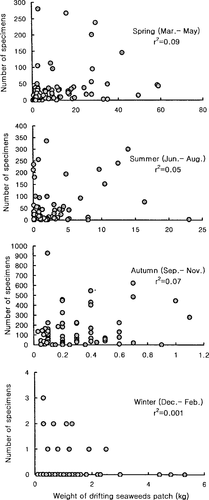
Relationship between the weight of the drifting seaweed patches and the number of fish collected, by season
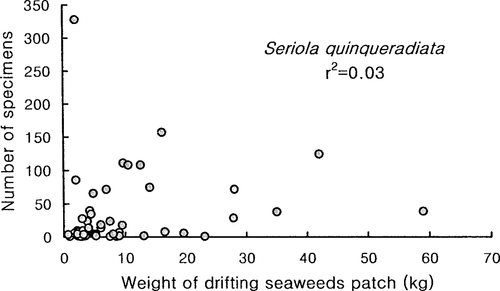
Relationship between the weight of drifting seaweed patches and the number of juvenile yellowtail collected in the coastal area of Tongyeong, Korea
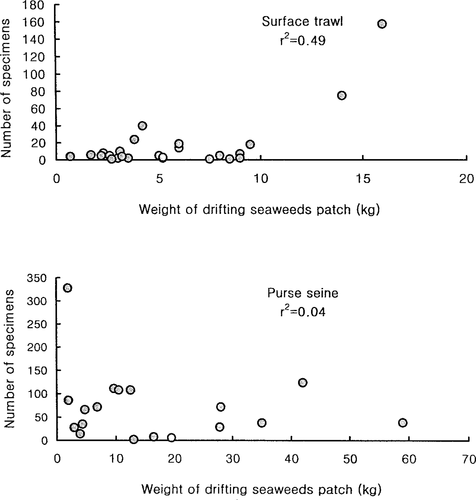
Relationship between the weight of drifting seaweed patches and the number of juvenile yellowtail collected by surface trawl or purse seine in the coastal area of Tongyeong, Korea
Behavior Patterns around Drifting Seaweed
The fish community was most diverse in May (Figure 10). Syngnathus schlegeli and Hexagrammos agrammus tended to lean on branches of drifting seaweed, and Pholis species were observed winding their tails around branches. A school of Sebastes thompsoni and Seriola quinqueradiata swam beneath the seaweed, the smaller members of the latter species remaining particularly close to the drifting patches. In the field, we observed that more fish tended to gather in drifting seaweed that clustered tightly and had branches extending down about 1 m below the surface.

Diagram of the distribution of fish in and around drifting seaweeds in the coastal area of Tongyeong, Korea (May 1998). Fish species are as follows: A, Hexagrammos agrammus; B, Pholis nebulosa; C, Sebastes thompsoni; D, Histrio histrio; E, Gasterosteus aculeatus; F, Trachurus japonicus; G, Sebastes inermis; H, Seriola quinqueradiata; and I, Petroscirtes breviceps
Discussion
Sargassum spp., the most abundant elements in drifting seaweed patches, were often entangled with fragments of rope, net, and some other artificial materials; this finding corroborates that of an earlier Japanese study (Ikehara and Sano 1986). The drifting seaweed patches were largest in spring and smallest in winter, which corresponds to the seasonal growth patterns of Sargassum spp. Wind and currents are the important factors in forming drifting seaweed patches, which serve as nurseries for many juvenile fish (Safran and Omori 1990) and are breeding sites for Cololabis saira (Pacific saury) and Hyporhamphus sajori (harfbeak; Uchida and Shojima 1958). Intensive observations have been made by air to evaluate the resource stocks of juvenile Seriola quinqueradiata in and around drifting seaweed (Mitani 1965a, 1965b, 1965c, 1967). In the present study, 56 species of 27 families were collected from drifting seaweed. During this same period, 76 species of 35 families were collected in plankton nets (Park 2000). These results suggest that many fish species in this area use seaweed for shelter in the early stages of their life cycles.
The number of species increased from March (N = 6) through May (N = 29) and June (N = 26) and decreased in July, which suggests that the occurrence of fish species is influenced by their breeding seasons. This seasonal pattern was also observed in fish larvae and juveniles collected in plankton nets (Park 2000).
Two groups of fish were found in the drifting seaweed. One was the group of long-term resident fish, including Histrio histrio, Syngnathus schlegeli, and Petroscirtes breviceps. Of these, Histrio histrio ranged in length from 10.5 to 147.3 mm and seemed to live and feed among the drifting seaweed. The other group, was comprising short-term residents, included Seriola quinqueradiata, Trachurus japonicus, and Scomber japonicus, which were collected only between May and July.
The species in each fish community in our study differed according to the three types of sampling nets used. Dip nets collected mostly Pholis nebulosa (FO = 20.6%), followed by Sebastes thompsoni and Hexagrammos agrammus. Surface trawling collected Sebastes thompsoni (41.1%), Seriola quinqueradiata (18.7%), and Stephanolepis cirrhifer (11.1%). Purse seines collected mostly Seriola quinqueradiata and Sebastes thompsoni (FO = 37.6% and 32.6%, respectively).
Juvenile Seriola quinqueradiata were collected from the open sea within the study area in May, particularly in the vicinity of Kukdo and Chwasarido. The total length of samples, measured in the laboratory, ranged from 12.9 to 135.4 mm. These results are similar to measurements of Seriola quinqueradiata juveniles collected in the East China Sea, where sizes ranged from 18.4 mm (for 33-d-old fish) to 113.8 mm (88-d-old fish; Sakakura and Tsukamoto 1997). We assume juvenile Seriola quinqueradiata inhabit the drifting seaweed patches for 30–90 d posthatch.
The striped pattern on the bodies of Seriola quinqueradiata and Thamnaconus modestus is believed to be an adaptation to the drifting seaweed environment, as with Siganus fuscescens (Uchida and Shojima 1958). Comparing the composition of juveniles found in our study with those from plankton samples (Park 2000), we found that Hyperoglyphe japonica, Oplegnathus punctatus, Kyphosus bigibbus, Kyphosus lembus, Cypselurus spp., and Seriola spp. were collected only in drifting seaweed. These species inhabit the open sea during the larval stages and are assumed to float with drifting seaweed toward coastal areas. In a study of a larval community, Park (2000) collected Sebastes thompsoni 4.5–4.6 mm long in April, whereas individuals 12.8 to 36.6 mm long were found in drifting seaweed between April and June. Sebastes thompsoni therefore seems to spend the larval stages in plankton and to move to drifting seaweed after reaching a length of about 10 mm.
Gooding and Magnuson (1967) defined three types of fish response to floating substrates: the “transient” type, which shows no response and makes no contact; the “visitor” type, which shows a response but makes no contact; and the “resident” type, which both shows a response and makes contact. In the resident type, two subtypes are recognized: an “obligatory” group, which lives in seaweed patches, and a “nonobligatory” group, which approaches the seaweed after responding to the substrate. Gooding and Magnuson (1967) classified Hyporhamphus sajori, Hexagrammos otakii, and Hexagrammos agrammus as obligatory groups of the resident type. However, because they use drifting seaweed as their breeding sites by attaching their bodies to the substrate, we conclude that they should be reclassified into the nonobligatory group.
To understand fish ecology in drifting seaweed, an integrated study must be conducted in fields of seaweed. Further studies of plankton ecology around seaweed and the food webs among drifting seaweed, are also required.
Acknowledgments
This study was supported by a grant PM 98-005-00 of Korea Ocean Research & Development Institute from the Korea Ministry of Maritime Affairs & Fisheries. We thank Yong-Joo Park, Do-June Kang, and Tae-Woon Chyung for their assistance in the fieldwork. Also, we thank Duk-Hyun Yoon for the constructive comments on the manuscript.




